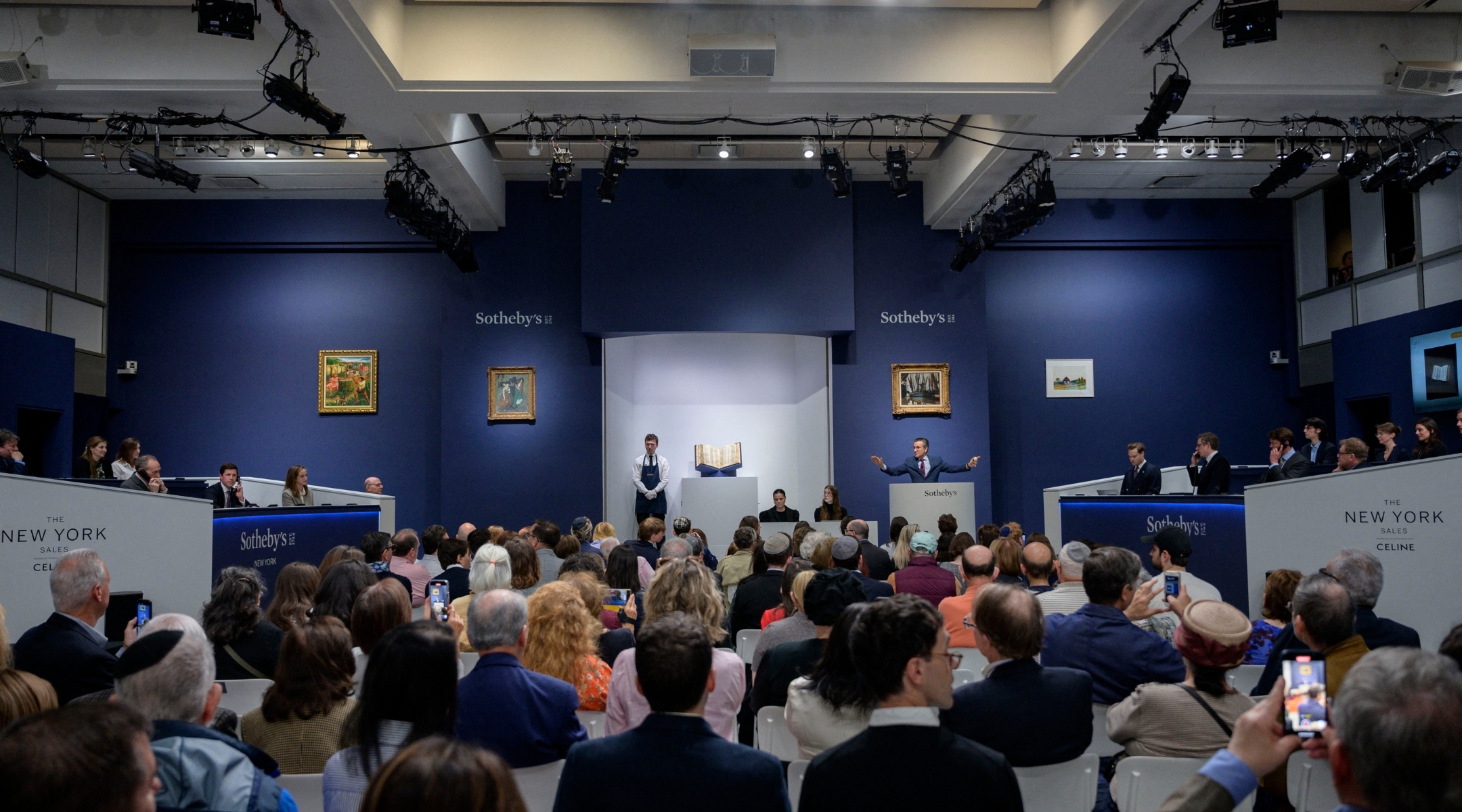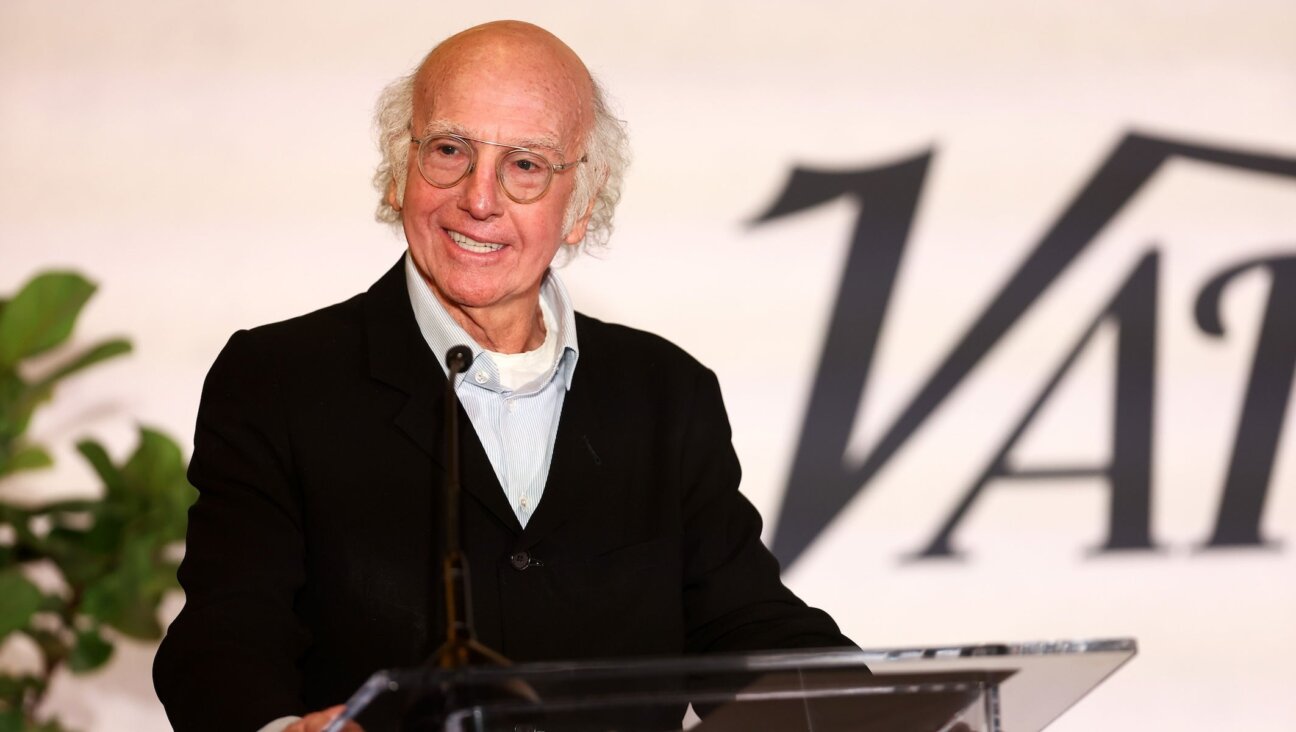Codex Sassoon acquired by ANU Museum of the Jewish People for $38.1 million
The 1,100-year-old Hebrew Bible became the most expensive book ever sold, though not the most expensive document

Sotheby’s auctioneer Benjamin Doller takes bids for the Codex Sassoon (Angela Weiss/AFP/Getty)
(JTA) – A 1,100-year-old Hebrew Bible became the most expensive book ever sold Wednesday when it drew a price of $38.1 million at auction at Sotheby’s in New York City.
The buyer of the item, known as the Codex Sassoon, was revealed to be the Museum of the Jewish People in Tel Aviv. The museum said Alfred Moses, a former U.S. ambassador to Romania, and his family provided the funds for the purchase.
The manuscript is the world’s oldest nearly complete copy of the Hebrew Bible. It was handwritten roughly 1,100 years ago on 792 pages of sheepskin, includes all 24 books of the Bible and is missing only about eight pages. Its writing and layout recall those of Torah scrolls read in synagogue.
The seller, Swiss financier and collector Jacqui Safra, had owned the volume since 1989. Speculation about where the book would end up led to anxiety that it might be sold to a private collector rather than a public institution that could put it on display.
Those doubts were put to rest when the museum, formerly the Museum of the Jewish Diaspora and also known as Anu, said the book would be part of its core exhibition.
“The Hebrew Bible is the most influential book in history and constitutes the bedrock of Western civilization. I rejoice in knowing it belongs to the Jewish people,” Moses said in a statement. “It was my mission, realizing the historic significance of Codex Sassoon, to see that it resides in a place with global access to all people.”
Just a handful of buyers competed for the book — in person at Sotheby’s and by phone — and the auction took less than six minutes. Ahead of the auction, Sotheby’s estimated that the item would sell for anywhere from $30 million to $50 million. The “gavel price” was $33.5 million, but with fees and premiums, the final price tag reached $38.1 million.
Since no book or historical document quite like it has been sold at auction for decades, the Codex Sassoon has earned comparisons to other foundational texts of civilization that have also commanded tens of millions of dollars. A copy of the first printing of the U.S. Constitution’s final text sold for $43.2 million in 2021. The Codex Leicester, a journal with writings by Leonardo Da Vinci, fetched $30.8 million in 1994. And a copy of the Magna Carta sold for $21.1 million in 2007.
“This is one of the rarest, unique, uniting documents that ever existed,” Irina Nevzlin, chair of Anu’s board of directors, told JTA. “For us to have it in the museum where it will be available for all those millions of people — this is something that can strengthen our roots and our identity, because it’s something eternal.”
She added, “We are the right home for it for so many reasons. Also for the fact that we’re based in Israel.”
The in-person auction attracted a standing-room-only crowd of onlookers, many of whom said they felt compelled to witness a transaction of immense significance in Jewish tradition.
“This is a historic moment,” said Elinatan Kupferberg, a scholar and writer from Lakewood, New Jersey. “This is the oldest Torah in existence. Whoever is going to own it next is going to change history.”
Kupferberg, who said his most precious books were those containing the handwritten notes of great rabbis, said he sometimes regrets when Jewish texts are bought by collectors because they will not be used in everyday study. Not so, he said, with this item.
“It doesn’t make me feel sad to see it behind glass because it was meant to be a reference work,” he said.
Sandra Gogel, who was in town from Paris, said she had hoped the Codex Sassoon would draw a higher price, and was surprised that bidding had closed so quickly. “33.5 is nothing to scoff at, but 50 would have been nice,” she said.
Gogel said she had traveled to London to see the Codex when it was on display there and was relieved that the book will end up on public display.
“I went to London to see it because I thought I might not see it again,” she said. She added, “I’m happy it will be Israel where everyone can see it… Everyone goes to Tel Aviv.”
This article originally appeared on JTA.org.





















